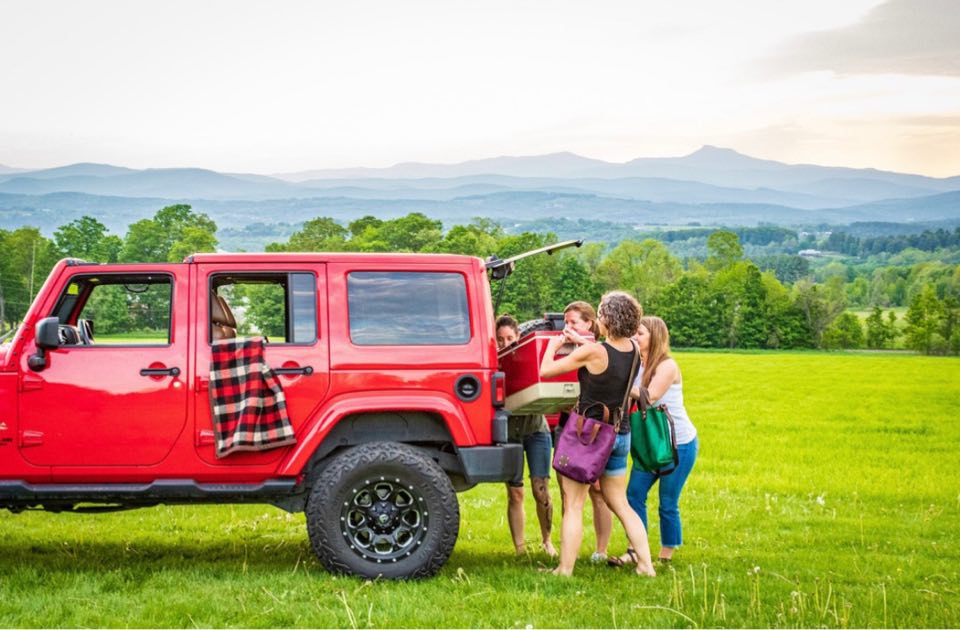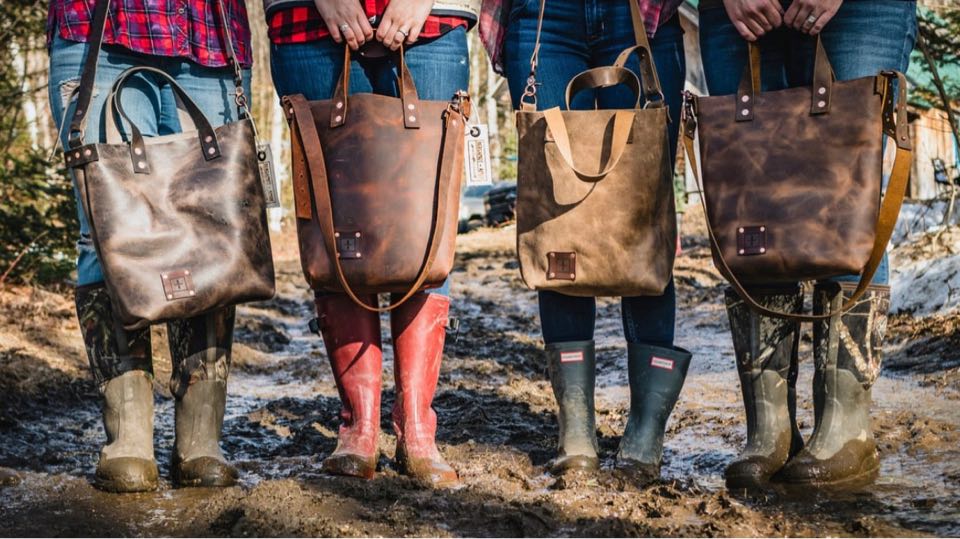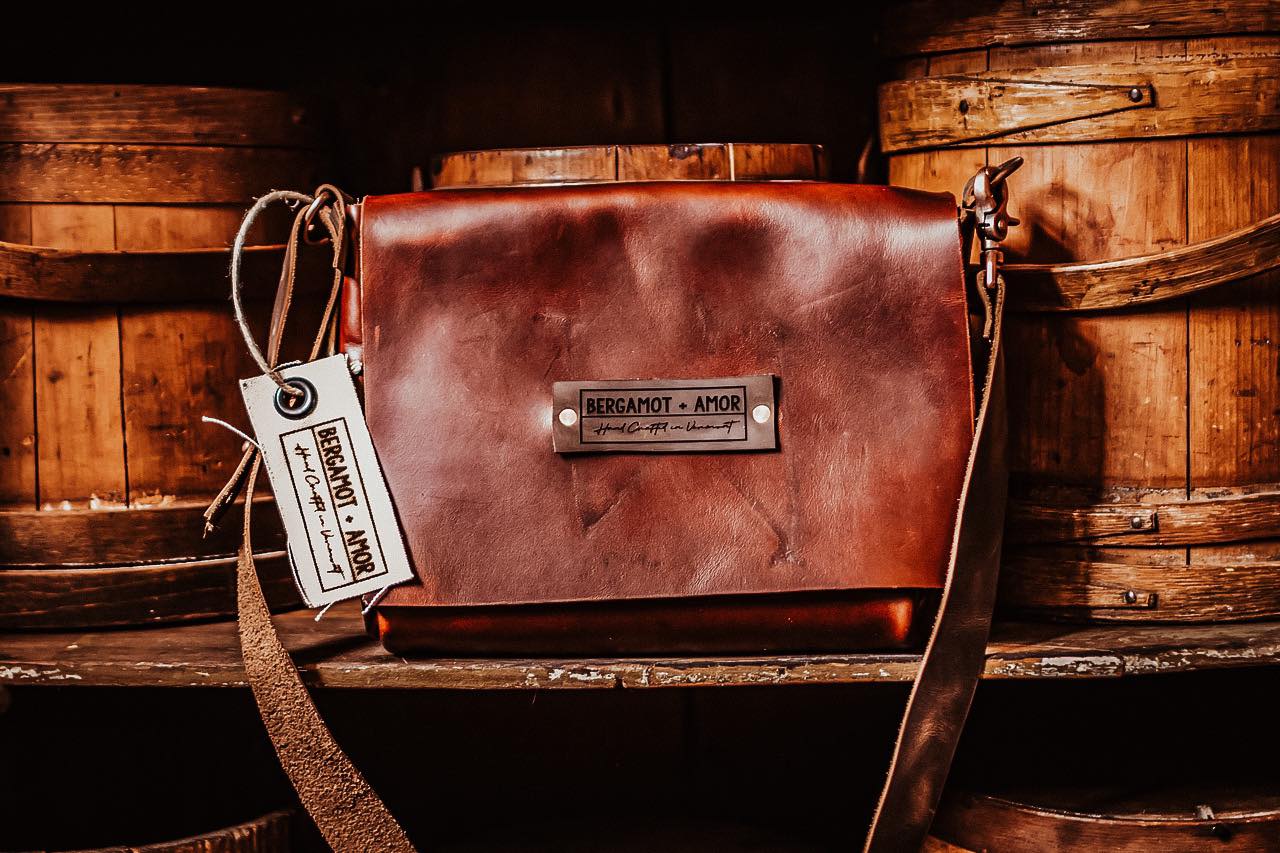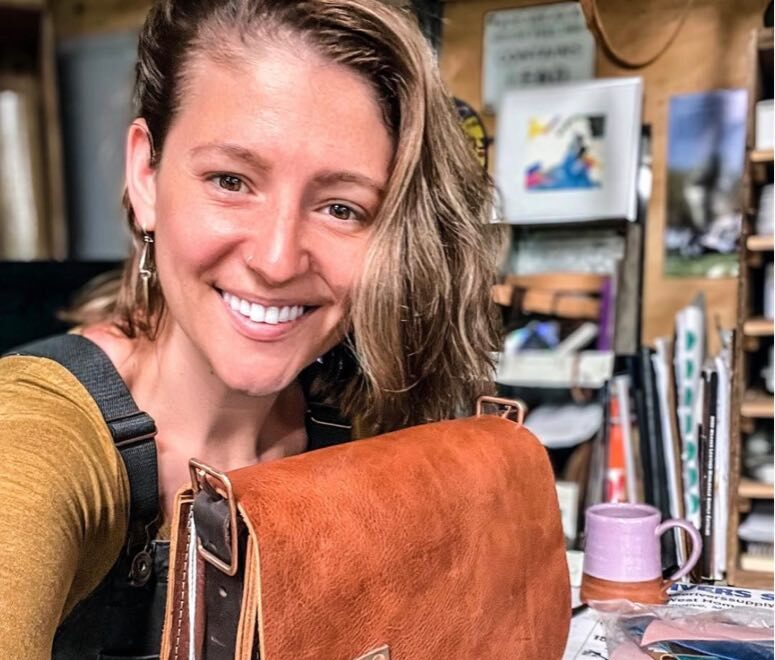A Vermont Business With Integrity and Heart
Amanda Farrell started Bergamot + Amor out of her need for a high quality leather bag to carry art supplies. She teamed up with her business partner (and now fiance) to make one themselves, but had no idea so many other people would want one too. Fast forward a few years and Bergamot + Amor has become so much more than bags. The duo have set out to use their company as a catalyst to revitalize their crumbling town in Vermont from the inside out, and they’re already making more of an impact than you could imagine.
Tell us about your business and what it is?
Bergamot + Amor is a high-end luxury leather goods store that is based in the small and withering town of Williamstown, Vermont. We hand make bags, purses, wallets, belts, functional art with 100% USA top grain boot leather and solid copper hardwear.
How did you get into working with leather?
It happened by accident, believe it or not. I have dabbled a little in upholstery weight leather, but never anything this rugged. It all started when I connected with Peter, my business partner and fiance’, through fine art. I was painting to sustain a living. I’ve always been creative, I’ve always loved to draw and paint. Peter hired me to paint a mural at his home in Williamstown, and then some holiday cards, and 2D wall art. He was doing upholstery, primarily high-end automotive. I was really hoping that I could sweet talk him into making me a bag to carry my art supplies in that was top grain leather. He had yet to work with anything this tough so we decided to collaborate a bit– each buying some materials/equipment. I drew out an idea of what I was looking for and Peter assembled it.
I loved it so much I decided to share it on my social media, and overnight we had 14 requests for purses. It just kind of snowballed.

So cool to have demand before you even really start! How do you come up with new styles or products now? Do you find or develop patterns before making something or figure it out as you go?
Peter and I both almost daily put together inspirational images of products we’ve seen or thought about and are constantly thinking about ‘what’s next.’ We have notebooks in our shop where we drop images or tack product ideas and draw on and write notes.
Once we have an idea that is cohesive that we feel warrants production we start cutting scrap materials to formulate a prototype. Typically within 3-4 test runs we settle on a pattern and then we cut one clean and clear pattern to use as a template.
We then use our template to make 5-10 trial items that we hand out to different ‘testers’ or loyal customers who we can trust to trial the product and give us clear honest feedback. We want to know what’s working, what’s falling short, what the true needs / wants of the consumer are.
After about a month of collecting data and feedback, we revise our pattern as needed and then push our product out and into the store where local consumers can purchase it. If the product seems to get a good response, or gets a worthy review via sales, we then move it to our website where folks across the country can purchase. This method not only allows our locals to claim first dibs, but also gain access to products right off the bench. Things that are one-of-a-kind, and very personal.
It sounds like it could be complicated to figure out how to get this kind of material and know how to work with it. How do you actually obtain/source your leather and what are the implications?
You’re right. Leather is tricky. It’s not something that’s super forgiving to work with, it’s stiff, it can be rigid. There are a million reasons why folks might think twice about using it. Our reasoning as to why, is pretty simple. Leather is SUSTAINABLE. We use 100% byproduct leather that is coming from ‘waste’ within the USA meat and dairy industry within the USA. Every day hides are being buried in the ground from farmers across the country. Often this is a major financial and economical burden on our already struggling farmers. Many have to pay to have a meat processing plant dispose of their hides, or they must find a way to safely bury them in the ground without inviting predators to their farms that may harm or hunt their livestock. There is this HUGE misconception that leather tanning is bad for the environment, that only harsh chemicals can be used to tan leather and that it damages waterways and pollutes the environment. The reality is tanning leather has been around since ancient Egyptian times. It’s culturally ingrained in our ancestral history and can be done with very simple CLEAN techniques that don’t tax our environment. The mentality and rhetoric that it’s not sustainable was created by giant textile mills and was used as an excuse to move tanning overseas to skirt EPA laws, for folks to use nasty cheap chemicals in their dying process, rather than invest locally and follow rules that quite frankly, might not be the CHEAPEST, but are fairly simple and clear.
American consumer culture struggles with quality over quantity, and as a business, sure, we understand the dollar value, but as Vermonters, we believe in longevity and the ethics behind doing something perhaps ‘the hard way.’ Cheap and Easy doesn’t always win the race.
So true! When you were first getting going, how did people find out about you and where did you get your customers?
Our company truly started by me posting Peter and my creation on Facebook. That first bag that we made for my art supplies hit just at the right time, and resonated with the right people. Within the first week of sharing our first bag, 14 people reached out to find out where to buy one. I told Pete, “Hey, I think I’m going to do this full-time,” and he kind of just looked at me crazy, like I had five heads. He said he’d help where he could, but he was busy with his upholstery business. We both had work lined up with clients, for painting and upholstery. I called all of my clients, returned painting deposits and within two days, Peter did the same. It’s been full-steam ahead since we started.
Did you always think you’d be a business owner?
As a child I always dreamed of being an artist. I really wanted to illustrate children’s books. I have severe dyslexia and was diagnosed very young. I was always the kid causing trouble or unable to sit still in classrooms (dyslexia can mimic ADHD). My favorite memories all existed in The Calais elementary school library where Karen, the librarian, would have an hour long class. She would pick out a new children’s book or two, we’d all sit in a circle and she’d read to us. Listening to someone read, when I barely could, just made the pages of the book come alive. I first learned of Mary Azarian woodblock prints there, Snowflake Bently, The illustrations of Mark Buehner in Balloon Farm. It was this safe and colorful place where my brain would just run wild every week. To this day those books and stories still fuel me. Those memories were pivotal for me.
Did you know going into it that it would be a profitable business or did you go into it more for the love of making? What was the business plan like, if it existed, and how has it changed over time?
This makes me smirk. We never had a plan. We had this new product, and new passion that we had SO much fun making together and we just blindly ran with it. I guess the blessing in disguise for Peter and me both is we’ve known financial hardship, so we weren’t afraid to fail because we’ve been broke and poor before and we knew that the worst case scenario was that we would just have to go back to what we were doing prior if things didn’t work out financially. We are pretty simple people who can survive comfortably without a lot of extra things. If you saw our house or asked our kids they’d tell you we live like cave people. Okay, I’m exaggerating a little. But our home has been in the middle of DIY home reno for nearly 2 years, and we did go probably 8 months without a bathroom door. Lol. We are self employed; we reinvest almost every dollar so that hopefully, we can grow the business and create a future where we can live comfortably and teach our children the value of hard work and the balance of need over want. Sustainability and ethics. It goes so much further than just a leather bag business.
How did you decide to go into business as a partnership? What has that been like?
It was a no brainer. I fell in love with Peter and I fell in love with a product and the two had to go together. I wouldn’t have it any other way.
You recently opened a storefront after selling online for the first few years. How was that the natural next step for you? Was it always in the plans?
Everyone looked at us like we were crazy when we said we wanted a storefront. (Well, all of our financial and business advisors– our customers were like heck yes! A store!) We started this business in the heat of Covid–19. Everything was closing, everyone was moving to e-commerce platforms, and yes, e-commerce was great to us in our first couple of years. But at the end of the day, leather is tactile. We were drowning in requests from folks wanting to come to the workshop (our single bay garage) and shop. The last month, prior to opening the store, we hosted an ‘open shop’ where we opened our workshop to the public. Vermont Covid-19 guidelines had changed and we finally could open up to the public and we had over 400+ people show up to shop at our home!
We hired a band and had a new local restaurant set up a tent in our driveway and cater the event, so you could finally grab a cocktail, shop purses in our garage, hang out on our lawn among the rolling hills of Vermont. We had roughly 10 other makers come and set up pop up tents, so it felt like a farmers market. It was sunny and the community just rallied together unlike anything we have ever seen in our lives. It was truly magical.
After that event Peter and I knew, against all financial advice from our bankers, accountants and small business specialists, that we needed to go against the trend. We spent all of our savings, and trusted the consumer. It was time to open a storefront, and yeah, we were totally terrified. But the old “brick and mortar is dead” mentality just would not settle with us. We were seeing the want and need with our own eyes.

That is an absolutely incredible origin story. Tell us more about the process of finding the space and bringing the store to life.
Peter and I, to decompress, often take our old car out for a ‘cruise.’ It’s this divey old Ford LTD II that’s sun faded powder blue. It’s so ugly it’s amazing, basically a mullet on wheels. (Pete traded it for an upholstery job right after we met.) When we spend long days inside the garage creating product, getting in the old car, getting off our feet, packing a picnic and taking a cruise down the windy back roads of Vermont always seem to center us and keep our moods light. Well, one day, we were headed through town, and Pete said to me, “That building, that one right there, if we were to have a store, that’s the only place I’d want to open it.” I was thinking the exact same thing and I just kind of squeezed his hand, and I said, “It would be pretty amazing to see that building come back to life.”
Within days of saying it out loud we learned the buildings were actually going up for sale. The owners were elderly, lived over an hour away and they just couldn’t care for the property any longer. It had sat vacant for almost 15 years, so we called them, told them our story and about our business and our goals for the town. Three days later we shook hands and made a deal to purchase the buildings before January 1st of 2023. What the old owners didn’t know was that Peter and I had absolutely ZERO dollars saved at the time. We had reinvested literally all of our money into materials to prep for an upcoming fair at Eastern States Expo called The Big E! By nothing but luck we were chosen to represent the State of Vermont in a juried vote as one of “Vermont’s Best in Business” inside the mock Capitol Building on the Avenue of States. Our company was only a year old, and here we were preparing to stand on one of the largest platforms for Vermont business owners on the east coast, next to Ben & Jerry’s and Cabot Cheese! Bergamot + Amor, the small town nobodies that make leather bags out of their garage in a crumbling town that most people never visit.
Fast forward now to 100+ days into having opened our shop I can tell you, nothing lights a fire under you more than making a handshake deal and knowing you only have X amount of days to make it work. There was no grace of god, or miracle, there were 19 hour work days, 7 days a week, for as long as we could physically stand until we were able to get a down payment large enough for one bank to take our start up business seriously. We did it. We purchased The historic Beckett Block known as “The Beehive” in town history books along with the Old Farm N’ Country hardware store that had gone out of business on the same parcel of land and we are in the process of revitalizing this old and dying town one purse at a time.
Our new property will house all of the following:
Bergamot + Amor Factory Store & USA Artisan Gallery
Bergamot + Amor Manufacturing Facility
Two Apartments (which were occupied when we acquired the buildings)
A new AirBNB called The Loft at The Beehive
A new Full Service Salon & Day Spa called Beehive Beauty Co.
The Grain Storage – Rentable Town Event Space and Community Venue for Concerts, Food Trucks and Culture
Wow. Much more than just a store! What would you say is the larger mission of the space? What are you hoping to bring to the area by creating this?
Our company mission is to give back to everyone around us and to help rebuild our town that has been without opportunities for 30+ years when manufacturing left the states. We believe in offering good paying jobs, with benefits and long term growth opportunities. We believe in having community spaces for folks to gather and laugh and spend time getting to know one another that isn’t necessarily wrapped around alcohol, places like the old general store way back in the day where kids had a safe place to ride their bikes, and grab a soda and penny candy. People miss the connection to our natural surroundings and to our neighbors. Peter and I are really really focused on bringing that back.
In addition to your products, you feature and sell other small maker products in the shop. How do you go about finding them and what is that process like for you and them?
Yes! We do! Our Artisan Gallery shows over 150 USA based artists. We have a lot of Vermonters, but also a significant number of other crafters that we’ve connected with via social media and word of mouth who create anything from sculpture to wearable art. We consign work as well as buy collections outright at wholesale prices so we can display and resell it all at the artist’s set MSRP.
You also give back a portion of your profits to local causes- tell us about that and how it fits into your business plans and mission.
Peter and I donate nearly 30% of all of our annual profits back to struggling members within Vermont communities. We participate in nearly any and all silent auctions & raffles that we hear of, we sponsor sports teams so less fortunate kids have access to athletic programs and uniforms and proper gear and don’t have to feel the burdens of their parents’ poverty levels. We buy 20+ lunches a week at local stores and restaurants to help provide healthy meals to struggling folks or just as a kind gesture. Any and every way we can drop a couple dollars, not that we have many, but the goal is to make an impact that has a ripple and that people can actually see and feel.
What’s it like creating a business in a small town so close to where you grew up? Has the community been extra supportive? Or are there any specific challenges?
It’s funny, Williamstown isn’t that far from my hometown. Vermont is small. When I was a kid my mom had a house rule that we weren’t allowed to date boys from Williamstown. It’s always had this reputation of being super rough and rowdy. It was like the wild west of Vermont. Not to mention just kind of out of the way. Like I said, there hasn’t been much here for decades. Needless to say, after art school and moving around a bunch I bought my first home in Graniteville Vermont, a neighboring town. And then met Peter, the love of my life, who is a Williamstown native and deeply rooted here. His passion for this town is contagious. I think a lot of folks think of me as an outsider, many don’t actually know I grew up just a few towns over, many think I’m some wealthy hot shot that shacked up with Pete and that I’m some private investor with a bottomless pocket. When they find out I grew up poor by a widowed single mom in East Calais Vermont it blows their mind. Our locals, especially the ones who know Peter and who take the time to get to know me are ridiculously supportive and we know with time and exposure our story will get out there.
What has been one of the biggest interesting challenges you’ve faced since being in business?
Our biggest challenge is properly managing how quickly to grow and how many hours there are in one day. Right now Peter and I still do everything alone with the exception of one high school student who helps us three to four nights a week after school and we recently recruited Peter’s cousin Ashley to help in the Artisan Gallery. We are trying to penny pinch without sacrificing livable wages for our employees and fair hours, which means right now Peter and I often don’t pay ourselves and we still work 19 hour work days 7 days a week. We know this won’t always be the case, but we understand the value in keeping hard working employees and making sure their lives and well being are a priority.
Being a business owner is hard work- do you do anything to wind down after a long day or week? Or have any routines that keep you grounded?
Awesome question! Pete and myself are total work-aholics. We have a hard time relaxing or sitting still if we aren’t making or creating. The only exception to that is scenic rides in the old car, on rare occasions I’ll let myself sleep until 8 am on Sundays, or we’ll duck out of town to visit Peter’s mom in Wells, Maine. Our weekly decompressor is ritualistically right around midnight most nights. After closing up our garage workshop, Pete and I stretch out on the living room floor in front of the woodstove before bed and rub each other’s feet and loosely plan the following day.
We talk about things we want to do differently, or ideas for new products, or recap something that happened. We truly LOVE what we do, so although it’s stressful and we do it endless hours, day in and day out, it still doesn’t feel as stressful as a day in the office ever felt. We both go to bed late, and rise no later than 6 am ready to jump right back in.
Anything you specifically try to do together or apart in order to keep some kind of work/life/relationship balance?
Working day in and day out with your partner is definitely not something everyone can do. My recommendations to anyone who is brave enough to jump in with both feet with their significant other in business is:
- Don’t half-ass anything, effort needs to be all or nothing.
- Always and I mean always, take time to explain your point of view and be receptive to ideas that might not be what you had originally imagined. Flexibility is everything, and you’ll learn that neither of you know it all. That normally the best method is a collaboration of ideas you both had.
- Make sure you stop to take breaks and drink water, eat a meal, and take an hour or two to go run errands solo, or give yourself space to get organized.
- At the end of the day, tell one another thank you. Like genuinely look at one another and list off the things you are genuinely grateful for that your partner does and brings to the table. Never assume they know it. Always take the time, even if it feels awkward. Real time recognition for hard work will always be the number one most important part of working with your spouse or significant other.
Any specific plans for the future for the business?
Right now our plan is to keep going, and to see all of our construction and building plans through. We have so many new moving parts so right now our plan is to stay focused on making a quality product that people believe in and using our sales to generate funds to revitalize Williamstown, VT.
Connect with Amanda and Bergamot + Amor
BergamotAmor.com
facebook.com/BergamotAmor
instagram.com/BergamotAmor
